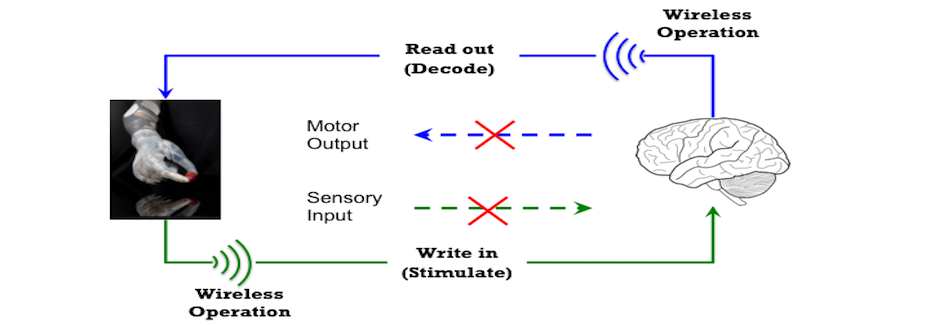About Oweiss Lab

Basic Neuroscience
My lab has a long-standing interest in investigating the neural mechanisms underlying sensorimotor integration, and the extent to which they can guide the engineering of clinically viable Brain machine Interfaces (BMIs). In particular, we seek to characterize the interaction between cortical and subcortical structures at the cellular and population levels during goal-directed behavior. Some sample publications:
- S. Eldawlatly, K. Oweiss, (2014) “Temporal precision in population - but not individual neuron - dynamics reveals rapid experience-dependent plasticity in the rat barrel cortex” Frontiers in Computational Neuroscience, Vol 8, doi: 10.3389/fncom.2014.00155
- S. Eldawlatly, K. Oweiss (2011) “Millisecond-Timescale Local Network Coding in the Rat Primary Somatosensory Cortex,” PLoS ONE 6(6): e21649. PMID: 21738751
- M. Aghagolzadeh, S. Eldawlatly and K. Oweiss, (2010) “Synergistic Coding by Cortical Neural Ensembles” IEEE Transactions on Information Theory, 56:2, 875-899, PMID: 20376281
- K. Oweiss, I. Badreldin (2015) “Neuroplasticity subserving the operation of Brain Machine Interfaces,” Journal of Neurobiology of Disease
Systems Engineering
We develop neural signal processing and feedback control algorithms for bi-directional neural interface systems. We further embed them onto application specific integrated circuits and optimize their size, power consumption and wireless operation for full implantation in the body. Some sample publications:
- K. Oweiss, Editor (2010), Statistical Signal Processing for Neuroscience and Neurotechnology, Academic Press, Elsevier, 1st edition, ISBN-13: 978-0-12-375027-3.
- S. Eldawlatly, Y. Zhou, R. Jin and K. Oweiss, (2010) “On The Use of Dynamic Bayesian Networks in Reconstructing Functional Neuronal Networks from Spike Train Ensembles”, Journal of Neural Computation, MIT Press, 22:1, pp. 158-189, PMID: 19852619
- F. Zhang, M. Aghagolzadeh, and K. Oweiss, (2012) “A Fully Implantable, Programmable and Multimodal Neuroprocessor for Wireless, Cortically Controlled Brain-Machine Interface Applications,” Journal of Signal Processing Systems, pp. 1-11, doi:10.1007/s11265-012-0670
- K. Oweiss, A. Mason, Y. Suhail, A. Kamboh, K. Thomson (2007) “A Scalable Wavelet Transform VLSI Architecture for Real-Time Signal Processing in High Density Intra-cortical Implants,” IEEE Transactions on Circuits and Systems, 54:6, pp. 1266-1278
Translational Neuroscience
We develop computational models of basal ganglia circuits to elucidate mechanisms of Deep Brain Stimulation (DBS) and the optimization of its parameters for a variety of conditions such as Parkinson’s disease, essential tremor and sensory restoration. We seek to provide a system level understanding of the mechanisms of DBS, and the development of feedback control techniques to make stimulation on demand (i.e. closed loop) in order to minimize adverse effects of current open loop stimulation. Some sample publications:
- J. Liu, H. Khalil, K. Oweiss (2011) “Model-based analysis and control of a network of Basal Ganglia spiking neurons in the normal and Parkinsonian states,” Journal of Neural Engineering, 8: 045002 (16pp), PMID: 21775788
- J. Liu, H. Khalil, K. Oweiss (2011)“Neural Feedback for Instantaneous Spatiotemporal Modulation of Afferent Pathways in Bi-directional Brain Machine Interfaces,” IEEE Transactions on Neural Systems & Rehabilitation Engineering, 19:5, pp 521-533, PMID: 21859634
- M. Grosse-Wentrup, D. Mattia, K. Oweiss (2011), “Using Brain-Computer Interfaces to Induce Neural Plasticity and Restore Function,” Journal of Neural Engineering, 8: 025004, PMID: 21436534
- J. Daly, J. Liu, M. Aghagolzadeh, K. Oweiss (2012), “Optimal Space Time Precoding of Artificial Sensory Feedback through Mutichannel Microstimulation in Bi-directional Brain Machine Interfaces “ J. of Neural Engineering, 9, 065004, doi:10.1088/1741-2560/9/6/065004
A full list of publications is available here (Pubmed, Google Scholar)